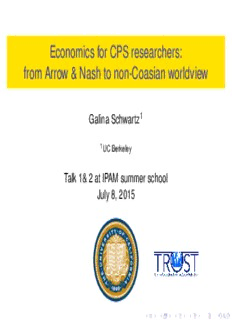
from Arrow & Nash to non-Coasian worldview PDF
Preview from Arrow & Nash to non-Coasian worldview
Economics for CPS researchers: from Arrow & Nash to non-Coasian worldview Galina Schwartz1 1UCBerkeley Talk 1& 2 at IPAM summer school July 8, 2015 Introduction From Arrow, Coase, & Nash to CPS Arrow theorem Coase theorem & Nash bargaining Preferences Arrow Impossibility Theorem From preferences to utility functions Cooperative bargaining theory [Nash bargaining solution] Coase Theorem Welcome to a non-Coasian World Non-cooperative bargaining theory [Stahl-Rubenstein] GALINASCHWARTZ (UCB) REVIEW Talk1&2,IPAM2015 2/44 Introduction Arrow impossibility theorem & its progenies Info: imperfect&asymmetric AdverseSelection:exante Causes MoralHazard:expost TransactionCosts Intteorapcrtoidnguce C[S1oo9ca6is0ae]lPTCrhoosebtolreemmof Re Ifincentives⇑=⇒inefficiencies⇓ A[1r9r5o1w] Theorem medies Contracts&mechanismdesign Regulations,Institutions todiIvnidteeracting NUatsihl.[1T9h5e0o,r’y5,3B],aRrguabinininstgeiTnh[e1o9r8y2] Infoasymmetry⇓&transactioncosts⇓ sharingadollar;propertyrights Arrow, Coase, Nash Bargaining [+ the tree of knowledge] GALINASCHWARTZ (UCB) REVIEW Talk1&2,IPAM2015 3/44 Introduction Preferences: Individual and Social Literature K.Arrow,1951.SocialChoiceandIndividualValues.Wiley,NewYork J.,Geanakoplos,2005.ThreebriefproofsofArrow’sImpossibilityTheorem.EconTheory26(1),211-215. http://link.springer.com/article/10.1007%2Fs00199-004-0556-7 Further readings A.Gibbard,1973.Manipulationofvotingschemes:ageneralresult,Econometrica41(4):587-601. M.A.Satterthwaite,1975.Strategy-proofnessandArrow’sConditions:ExistenceandCorrespondenceTheoremsfor VotingProceduresandSocialWelfareFunctions,EconTheory10:187-217. E.Kalai,E.Muller,M.A.Satterthwaite,1979.Socialwelfarefunctionswhenpreferencesareconvex,strictlymonotonic, andcontinuous,PublicChoice34-1,87-97http://link.springer.com/article/10.1007/BF00125755 P.Ray,1973.IndependenceofIrrelevantAlternatives,Econometrica.41-5,987-991. http://www.jstor.org/stable/1913820 GALINASCHWARTZ (UCB) REVIEW Talk1&2,IPAM2015 4/44 Introduction The roots and their connections Literature R.A.Coase,1960.Theproblemofsocialcost.JournalofLawandEconomics,1-44. J.NashJr,1950.TheBargainingProblem,Econometrica,18-2,155-162. http://www.jstor.org/stable/1907266 J.NashJr,1953.Two-PersonCooperativeGames,Econometrica,21-1,128-140. http://www.jstor.org/stable/1906951 A.DixitandM.Olson,2000.DoesvoluntaryparticipationunderminetheCoaseTheorem?,JournalofPublicEconomics, 76-3,309-335.http://www.sciencedirect.com/science/article/pii/S0047272799000894 Further readings A. Rubinstein,1982.PerfectEquilibriuminaBargainingModel.Econometrica50-1,97-109. http://www.jstor.org/stable/1912531 M.Yildiz,2011,NashmeetsRubinsteininfinal-offerarbitration,EconomicsLetters,110-3,226-230, http://dx.doi.org/10.1016/j.econlet.2010.10.020 J. Farrell,1987.InformationandtheCoaseTheorem,TheJournalofEconomicPerspectives,1-2,113-129. http://www.jstor.org/stable/1942984 P.Samuelson,1995.SomeuneasinesswiththeCoaseTheorem,JapanandtheWorldEconomy,7-1,1-7. http://dx.doi.org/10.1016/0922-1425(94)00040-Z T.Palfrey&H.Rosenthal,1984.Participationandtheprovisionofdiscretepublicgoods.JournalofPublicEconomics, 24-2,171-193.http://www.sciencedirect.com/science/article/pii/0047272784900239 GALINASCHWARTZ (UCB) REVIEW Talk1&2,IPAM2015 5/44 Preferences:individualandsocietal Preferences of individuals Preferences of an individual over alternatives PreferencesPi(or(cid:23)i)ofanindividualioveralternatives(x,y,...) I1 Preferences of each individual are complete (cid:23) i.e., defined for all pairs of alternatives I2 Strict preference: if x y then not y x (cid:31) (cid:31) I3 Ties are allowed, i.e., could be indifferent x y ∼ I4 Transitive: if x y & y z then x z (cid:23) (cid:23) (cid:23) Finite set of alternatives; finite set of individuals. GALINASCHWARTZ (UCB) REVIEW Talk1&2,IPAM2015 6/44 Preferences:individualandsocietal Preferences of the Society How to aggregate individual preferences? Definition (Social Preferences=Constitution) Let a constitution be a function that associates N-tuple (or profile) of transitive individual preferences with another transitive preference. Constitution defines social preference ordering. Definition (Dictator) An individual is a dictator if for every strict preference that he has, society strictly prefers the same ordering. GALINASCHWARTZ (UCB) REVIEW Talk1&2,IPAM2015 7/44 Preferences:individualandsocietal Arrow Theorem: descriptive assumptions (A1) The number of individuals is finite. (A2) There are at least three social alternatives. (A3) All combinations of individual preference orderings are admissible; for each combination a social preference ordering must exist. (A4) If everyone prefers a to b, then a is socially preferred to b. (A5) Let an individual have the same preference ordering for a and b in two combinations. Let the same be true for every individual. Then, the social preference between a and b shall be the same in the two cases. (A6) There is no individual such that when he prefers one alternative to another, then the first is socially preferred to the second. GALINASCHWARTZ (UCB) REVIEW Talk1&2,IPAM2015 8/44 Arrow’sTheorem Arrow Theorem: Formal Assumptions (A1) Society is a set of N individuals; N 1 | | ≥ (A2) (Alternatives) A 3 | | ≥ (A3) (Social Preference) societal ranking of all alternatives: societal preference profile π (A4) (Unanimity) If n a b then aπb n ∀ (cid:23) (A5) (Independence of Irrelevant Alternatives) Societal ranking of a & b depends only on how individuals rank a & b (A6) (No Dictator) (A1) Thenumberofindividualsisfinite. (A2) Thereareatleastthreesocialalternatives. (A3) Allcombinationsofindividualpreferenceorderingsareadmissible;foreachcombinationasocial preferenceorderingmustexist. (A4) Ifeveryoneprefersatob,thenaissociallypreferredtob. (A5) Letanindividualhavethesamepreferenceorderingforaandbintwocombinations.Letthesamebe trueforeveryindividual.Then,thesocialpreferencebetweenaandbshallbethesameinthetwocases. (A6) Thereisnoindividualsuchthatwhenheprefersonealternativetoanother,thenthefirstissocially preferredtothesecond. GALINASCHWARTZ (UCB) REVIEW Talk1&2,IPAM2015 9/44 Arrow’sTheorem Arrow (1951): Impossibility Theorem Theorem (Arrow: Version 1) (A1) - (A6) cannot hold simultaneously. Theorem (Arrow: Version 2) Any constitution that respects transitivity, independence of irrelevant alternatives and unanimity is a dictatorship. GALINASCHWARTZ (UCB) REVIEW Talk1&2,IPAM2015 10/44
Description: